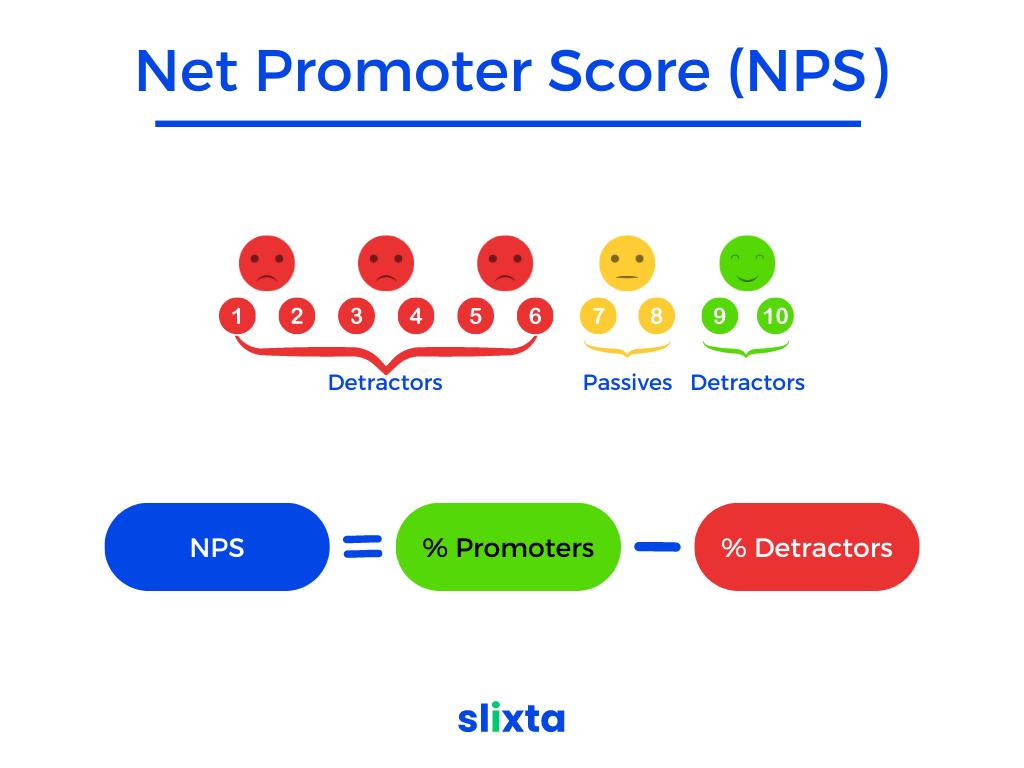Net Promoter Score (NPS) is a metric that measures customer loyalty by asking how likely customers are to recommend a business to others. It classifies customers into Promoters, Passives, and Detractors, providing insights to improve customer experience and foster growth through positive referrals.
Navigating life's significant choices often involves following a familiar pattern - scouring the internet for insights and seeking advice from friends and family. The influence of these recommendations cannot be understated. When it comes to businesses, a similar principle applies in deciphering the success of customer loyalty strategies.
This is where the Net Promoter Score (NPS) steps in as a powerful and widely adopted metric for assessing customer loyalty and gauging overall business growth.
Just like a well-crafted personal recommendation, NPS harnesses the power of a single question to gauge customer satisfaction and propel businesses toward success. Discover how this seemingly simple question can yield invaluable data, helping companies build lasting connections with their customers and thrive in the ever-changing market landscape.
What is Net Promoter Score (NPS)
Imagine walking into a bustling electronics store, searching for a new smartphone. The store is filled with a wide range of options, but you can't decide which one to choose. Suddenly, a friendly and knowledgeable sales representative approaches you, patiently answering all your questions and helping you find the perfect device. You leave the store delighted with your purchase, eager to recommend the store to your friends and family. Have you ever wondered what transforms a regular customer into a loyal promoter of a brand? That's where Net Promoter Score (NPS) comes into play.
Net Promoter Score (NPS) is a powerful tool that has revolutionized the way businesses measure and understand customer loyalty. It serves as a compass guiding companies towards building strong, lasting relationships with their customers.
NPS is a metric used to gauge the likelihood of customers recommending a company, brand, product, or service to their friends or colleagues.
The brilliance of NPS lies in its simplicity - it revolves around a single, key question:
"On a scale from 0 to 10, how likely are you to recommend our company/product/service to a friend or colleague?"
Based on their responses, customers are divided into three groups:
- Promoters (score 9-10): These customers are really happy and would enthusiastically recommend the company to others.
- Passives (score 7-8): These customers are somewhat satisfied, but they are not as likely to promote the company.
- Detractors (score 0-6): These customers are unhappy and might even say negative things about the company to others.
How to Calculate Net Promoter Score (NPS)
Now that we know the question, let's delve into the mechanics of NPS. The responses provided by customers are segmented into three categories:
- Promoters (Score 9-10): These customers are your brand advocates, enthusiastic about your product or service. They're not only loyal themselves but also actively promote your business to others, driving organic growth.
- Passives (Score 7-8): Passives are satisfied customers, but they lack the same level of enthusiasm as promoters. While they may not actively promote your business, they are unlikely to speak negatively about it.
- Detractors (Score 0-6): Detractors are unsatisfied customers who might voice their grievances to others, potentially harming your brand's reputation and hindering growth.
To calculate NPS, subtract the percentage of detractors from the percentage of promoters. The result can range from -100 to 100. A positive score indicates more promoters than detractors, signaling good customer loyalty.

History of Net Promoter Score (NPS)
The Net Promoter Score (NPS) was developed by Fred Reichheld, a business strategist, and author, in collaboration with Bain & Company, a management consulting firm. The concept was first introduced in a Harvard Business Review article titled "The One Number You Need to Grow," which was published in December 2003.
The simplicity and effectiveness of NPS resonated with businesses across various industries. It offered a straightforward way to measure customer loyalty, making it easier for companies to assess their performance and make improvements. As a result, NPS quickly gained popularity and became widely adopted by companies worldwide.
To facilitate the exchange of ideas and best practices related to NPS, Reichheld and Bain & Company established the NPS Loyalty Forum in 2003. This forum provided a platform for companies to share their experiences, challenges, and success stories in implementing NPS.
Over time, NPS became more than just a metric; it evolved into a management philosophy centered around customer-centricity. Many organizations began using NPS as a key performance indicator (KPI) and incorporated it into their overall business strategy.
Interpreting Net Promoter Score Results
Interpreting Net Promoter Score (NPS) results is crucial for understanding the level of customer loyalty and advocacy within a business.
NPS Score Range
NPS scores can range from -100 to 100. A positive score (above 0) indicates more promoters than detractors, while a negative score (below 0) suggests more detractors than promoters. The higher the NPS score, the more positive customer sentiment and loyalty.
Analyzing the Distribution
A balanced distribution of NPS scores is desirable, with a majority of customers falling into the promoter category. An NPS score between 50 to 100 indicates a highly loyal customer base, while scores between 0 to 49 suggest room for improvement. Negative scores call for urgent attention and action to address customer dissatisfaction.
Benchmarking
To gain deeper insights into the NPS results, companies can compare their scores with industry benchmarks and competitors. This helps to measure how well the business is performing relative to others in the market.
Follow-Up Actions
NPS is not just a score; it's a tool for driving improvements. Once the NPS results are analyzed, companies should take action based on the feedback received. Addressing the concerns of detractors and leveraging feedback from promoters can lead to enhanced customer experiences and loyalty.
The Power of Customer Feedback
You're steering a ship through uncharted waters. Without navigation tools or a map, you're sailing blindly, unaware of the dangers that lie ahead. Similarly, in the business world, operating without customer feedback is like sailing without a compass - risky and uncertain. Customer feedback is the true north that guides businesses to success, and its power lies in the valuable insights it provides.
Understanding Customer Needs
Customer feedback acts as a direct line of communication between your business and its most important stakeholders - your customers. It offers a glimpse into their minds, allowing you to understand their needs, preferences, and pain points. By listening to your customers, you can tailor your products or services to meet their expectations, ensuring you stay relevant in a constantly evolving market.
For instance, a clothing retailer discovers through customer feedback that their customers prefer eco-friendly and sustainable fabrics. Armed with this knowledge, the retailer pivots its sourcing strategy, leading to a surge in customer satisfaction and loyalty.
Identifying Strengths and Weaknesses
Just as a mirror reflects your image, customer feedback reflects your business's performance. It highlights both your strengths and weaknesses. Positive feedback reveals what you're doing right, helping you identify your competitive advantages and capitalize on them. On the other hand, negative feedback exposes areas that require improvement, enabling you to address shortcomings proactively.
For example, a restaurant chain gathers customer feedback and learns that their food quality consistently receives praise. However, they also discover that some customers find the wait times for tables too long. Armed with this information, the chain optimizes its seating arrangement and implements a reservation system, resulting in a better dining experience and increased customer retention.
Building Trust and Customer Loyalty
When you actively seek and listen to customer feedback, you demonstrate that you value your customers' opinions. This fosters trust and loyalty, as customers feel heard and appreciated. They are more likely to remain loyal to a business that cares about their feedback and takes action based on it.
Consider a software company that rolls out regular updates based on customer feedback. Customers notice that their suggestions are implemented, leading to increased trust in the company's commitment to delivering an exceptional product. As a result, customer loyalty skyrockets, and the company experiences reduced churn rates.
Enhancing Customer Experience
Customer feedback serves as a treasure trove of insights into the overall customer experience. It sheds light on critical touchpoints in the customer journey, allowing you to make data-driven decisions to enhance every interaction with your brand.
For instance, an eCommerce platform analyzes customer feedback and discovers that their checkout process is causing frustration due to multiple steps. By streamlining the process and adding a guest checkout option, the platform significantly improves its user experience, resulting in higher conversion rates and happier customers.
Preventing Customer Churn
Unhappy customers are like leaks in a bucket - if not addressed promptly, they can cause significant damage. Customer feedback serves as an early warning system, alerting you to potential churn risks. By identifying dissatisfied customers and reaching out to them, you have the opportunity to resolve issues, salvage the relationship, and prevent churn.
A telecommunications provider utilizes customer feedback to detect patterns of dissatisfaction among its subscribers. By proactively offering tailored solutions and addressing concerns, they reduce churn rates and increase customer retention.
Innovation and Product Development
Customer feedback is a wellspring of ideas and inspiration for innovation and product development. Understanding your customers' pain points and desires can spark creative solutions and lead to new product or service offerings that cater precisely to their needs.
A tech startup gathers feedback from early adopters and discovers that users want additional integrations with popular software tools. Leveraging this feedback, the startup releases integrations, attracting a broader customer base and gaining a competitive edge.
Sample NPS Survey Questions
- On a scale from 0 to 10, how likely are you to recommend our products/services to a friend or colleague?
- How likely are you to recommend our products/services to others, with 0 being "Not at all likely" and 10 being "Extremely likely"?
- How likely are you to refer products/services to someone you know, based on your experience with us?
- Considering your recent interaction with products/services, how likely are you to suggest our services to others?
- How inclined are you to endorse products/services to friends or family members on a scale of 0 to 10?
- How probable is it that you would speak highly of products/services to your acquaintances? Rate us from 0 to 10.
- On a scale of 0-10, how likely are you to recommend products/services as a potential workplace to your friends?
Difference Between Net Promoter Score and Customer Satisfaction (CSAT)
The Net Promoter Score (NPS) and Customer Satisfaction (CSAT) are two distinct customer feedback metrics used by businesses to assess different aspects of the customer experience.
NPS measures customer loyalty and advocacy by asking customers how likely they are to recommend the company's products or services to others. It results in a score on a scale from -100 to 100, indicating the balance between promoters (satisfied and loyal customers) and detractors (unsatisfied customers).
CSAT, on the other hand, measures customer satisfaction with a specific interaction or transaction. It asks customers to rate their satisfaction level with a recent purchase or service experience and results in a percentage score based on the number of satisfied customers.
While NPS focuses on overall loyalty and the likelihood of recommendation, CSAT assesses satisfaction at specific touchpoints. Both metrics serve important purposes in understanding and improving the customer experience, making them valuable tools for businesses to measure different dimensions of customer sentiment.
Conclusion
By leveraging NPS as a strategic tool, businesses can identify their promoters and detractors, target areas for improvement, and create customer-centric strategies that foster strong and lasting relationships with customers. Its not just a score; it's a call to action. By listening to customer feedback and taking proactive steps to address concerns, businesses can continuously improve and elevate the customer experience.

